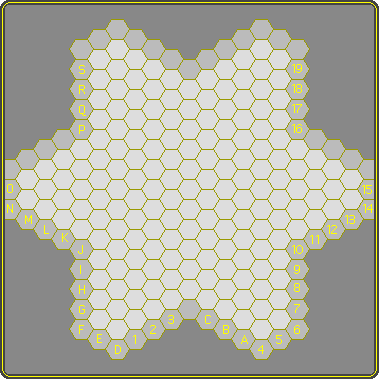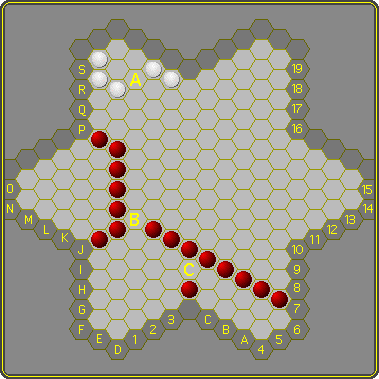The idea is implicitly present in SuperStar, but within a wider context. The game is played on a star-shaped board, with twelve sides that, in addition to stars, also allow the creation of superstars, connections with a much higher pointvalue, rendering a much higher reward for connecting them, and loops that allow for additional scores by surrounding territory or opponent's stones.
Its three sepatate goals are reminiscent of Havannah, Hexade and Rondo, while the pointvalues add a Go-like flavor.
Superstar eventually sparked YvY.
 | The ring of 60 cells surrounding the actual board is called the edge. It plays a role in defining a 'star'. The edge is not part of the playing area. In addition to defining a star, it is used for the coordinate system. For any cell, look left and right down the oblique lines to obtain its coordinates. Note that the 'D' and the '4' are shifted along the lines they define, to avoid having them end up on the same cell of the edge. The board has twelve sides. A side is formed by 5 cells: an inward corner, an outward corner and the 3 cells in between. Thus the six inward corners each belong to two sides. |
Rules
- The game starts on an empty board. Players move in turn to place one stone on a vacant cell. White moves first. Moving is not compulsary. The game ends when both players pass on successive turns, after which the counting takes place.
Object
The object of the game is to score more points than the opponent. Points are awarded for creating 'stars', 'superstars' and 'rings'. All of these are unbroken chains of connected stones of one color.
- A star is a chain touching at least 3 cells of the edge.
The value of a star is two less than the number of cells of the edge it touches. - A superstar is a chain connecting at least 3 sides.
The value of a superstar is 5*(S-2) where 'S' is the number of sides it connects. - A loop is a chain surrounding at least one cell.
The value of a loop is one point for every vacant cell it surrounds and 5 points for every opponent's stone trapped in it.
A chain may be a star, superstar and ring at the same time. Of course seperate counts are made in each capacity.
From the first definition follows:
- A single stone on an outward corner (touching 3 cells of the edge) is a 1-point star in itself.
- A connection between two previously disconnected stars makes the new star worth 2 points more than the sum of its previous parts, thus making connections pay off.
From the second definition follows:
- A single stone on an inward corner already 'connects' two sides, so that linking up with a third side will result in a 5 point superstar.
- A connection between two previously disconnected superstars that don't share a side, makes the new superstar worth 10 points more than the sum of its previous parts. Thus these connections pay off even more.
From both definitions follows that a superstar usually will also be a star. An exception is a chain that connects two inward corners without occupying other cells of the sides: this constitutes a 10 point superstar without being a star. An example is the seven stones black chain in the diagram below.
 | The white chains are a 2-point and a 1-point star respectively, but connecting at 'A' makes one star touching seven cells of the edge and thus worth 5 points, two more than the sum of the seperate parts. A chain doesn't even have to be a star to add thus if connected: if the rightmost white stone were deleted, the other one is no longer a star, but connecting at 'A' will still bring two extra points. The same can be seen at 'B', where a 10-point superstar is linked to a chain that is not a superstar itself because it touches only one side. The connection nevertheless brings 5 points. A further connection at 'C', to a stone that touches two sides but again without point-value in itself, even creates a 25-point superstar. |
Komi
The player moving second gets a number of points beforehand to compensate for the disadvantage of not moving first. Accurate komi have not yet been established.
Strategy and tactics
Superstars and connections between them obviously are prime strategic goals. Occupying two adjacent inward corners can hardly be wrong for starters. Loops are more dependent on a game's development and evolve later in the game when tactics come into play. Stars grow along the edge and are important in he endgame when the bigger issues have been settled. The center clearly is the area where the all important connections are made.
Ed van Zon - Christian Freeling (The Pit, 2008, 0-1)
a word on notation
Superstar © MindSports
Java applet © Ed van Zon
